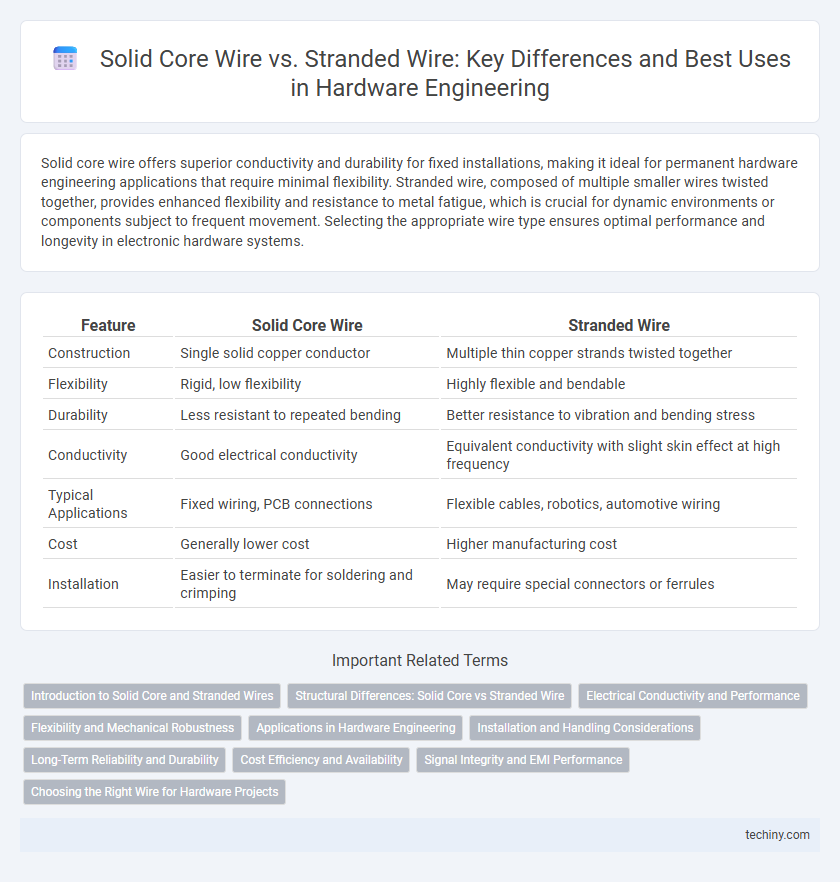Solid core wire offers superior conductivity and durability for fixed installations, making it ideal for permanent hardware engineering applications that require minimal flexibility. Stranded wire, composed of multiple smaller wires twisted together, provides enhanced flexibility and resistance to metal fatigue, which is crucial for dynamic environments or components subject to frequent movement. Selecting the appropriate wire type ensures optimal performance and longevity in electronic hardware systems.
Table of Comparison
| Feature | Solid Core Wire | Stranded Wire |
|---|---|---|
| Construction | Single solid copper conductor | Multiple thin copper strands twisted together |
| Flexibility | Rigid, low flexibility | Highly flexible and bendable |
| Durability | Less resistant to repeated bending | Better resistance to vibration and bending stress |
| Conductivity | Good electrical conductivity | Equivalent conductivity with slight skin effect at high frequency |
| Typical Applications | Fixed wiring, PCB connections | Flexible cables, robotics, automotive wiring |
| Cost | Generally lower cost | Higher manufacturing cost |
| Installation | Easier to terminate for soldering and crimping | May require special connectors or ferrules |
Introduction to Solid Core and Stranded Wires
Solid core wire consists of a single, solid strand of metal, typically copper or aluminum, which provides superior conductivity and durability in fixed installations. Stranded wire is composed of multiple smaller gauge wires twisted together, enhancing flexibility and resistance to metal fatigue, making it ideal for applications requiring frequent movement. Both types serve critical roles in hardware engineering, with solid core wires preferred for stable, low-flex environments and stranded wires favored for dynamic, high-flex scenarios.
Structural Differences: Solid Core vs Stranded Wire
Solid core wire consists of a single, solid strand of metal, providing superior rigidity and consistent electrical conductivity, which makes it ideal for permanent, fixed installations. Stranded wire is composed of multiple thin metal strands twisted together, enhancing flexibility and resistance to metal fatigue, suitable for applications requiring frequent movement or bending. The structural differences impact durability, with solid core wires being more prone to breakage under repeated bending, whereas stranded wires maintain integrity under dynamic conditions.
Electrical Conductivity and Performance
Solid core wire offers lower electrical resistance and improved conductivity due to its single, unbroken conductor, making it ideal for high-frequency and low-current applications. Stranded wire, composed of multiple thin strands twisted together, provides superior flexibility and durability but slightly higher resistance, impacting performance in long-distance or high-current scenarios. Electrical conductivity and overall performance depend on the specific use case, with solid core wire excelling in stable environments and stranded wire preferred for dynamic, vibration-prone conditions.
Flexibility and Mechanical Robustness
Solid core wire offers superior mechanical robustness due to its single, solid conductor providing consistent strength and durability under static conditions. Stranded wire excels in flexibility, composed of multiple smaller wires twisted together, allowing for enhanced bending and movement without breaking. Choosing stranded wire is ideal for applications requiring frequent flexing, while solid core wire is preferred for fixed installations demanding high structural integrity.
Applications in Hardware Engineering
Solid core wire excels in hardware engineering applications requiring rigidity and consistent conductivity, such as internal circuit board connections and fixed wiring installations. Stranded wire offers superior flexibility and durability, making it ideal for moving parts, robotic arms, and wearable electronic devices where frequent bending occurs. Selecting between solid core and stranded wire depends on the mechanical stress and electrical performance needs of embedded hardware systems.
Installation and Handling Considerations
Solid core wire offers easier installation in fixed, stationary applications due to its rigidity and straightforward termination process. Stranded wire provides superior flexibility, making it ideal for dynamic environments where bending and vibration occur frequently. Handling stranded wire reduces fatigue during installation, while solid core wire requires careful management to prevent breakage at stress points.
Long-Term Reliability and Durability
Solid core wire offers superior long-term reliability due to its single, solid conductor, minimizing the risk of breakage in fixed installations and maintaining consistent electrical conductivity over time. Stranded wire provides enhanced durability in dynamic applications by resisting metal fatigue and bending stress, making it ideal for environments requiring frequent movement or vibration resistance. Selecting the appropriate wire type depends on application-specific mechanical stresses and expected longevity demands, optimizing performance and reducing maintenance costs.
Cost Efficiency and Availability
Solid core wire offers superior cost efficiency due to its simpler manufacturing process and lower material usage, making it widely available in bulk for standard electronic and electrical applications. Stranded wire, while generally more expensive, provides enhanced flexibility and durability, which can reduce maintenance costs in dynamic environments despite higher initial investment. Availability of solid core wire is greater in standard gauges, whereas stranded wire is more specialized and may have longer lead times depending on specific strand counts and materials.
Signal Integrity and EMI Performance
Solid core wire offers superior signal integrity due to its consistent conductor geometry, reducing signal attenuation and minimizing impedance variations. Stranded wire provides enhanced flexibility but can increase electromagnetic interference (EMI) susceptibility because of multiple current paths and skin effect at high frequencies. For high-frequency applications requiring optimal EMI performance, solid core wire is typically preferred to maintain signal clarity and reduce noise.
Choosing the Right Wire for Hardware Projects
Solid core wire offers superior conductivity and rigidity, making it ideal for fixed, low-flex applications such as circuit boards and internal hardware connections. Stranded wire provides enhanced flexibility and durability against bending stress, suitable for dynamic environments and hardware projects requiring frequent movement. Selecting the right wire depends on project requirements for flexibility, current capacity, and mechanical stability, ensuring optimal performance and longevity of electronic hardware.
Solid Core Wire vs Stranded Wire Infographic

 techiny.com
techiny.com